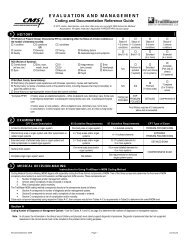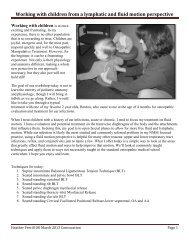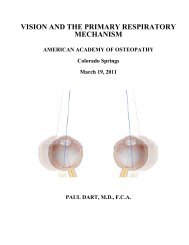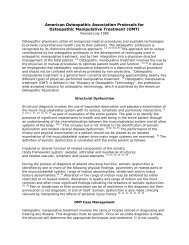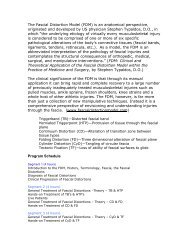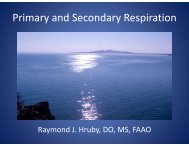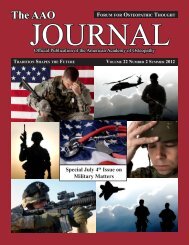Follow-up SOAP Note Usage Guide - American Academy of ...
Follow-up SOAP Note Usage Guide - American Academy of ...
Follow-up SOAP Note Usage Guide - American Academy of ...
Create successful ePaper yourself
Turn your PDF publications into a flip-book with our unique Google optimized e-Paper software.
Outpatient Osteopathic <strong>SOAP</strong> <strong>Note</strong>---<strong>Follow</strong>-<strong>up</strong> FormIntroduction:The following Outpatient Osteopathic <strong>SOAP</strong> <strong>Note</strong> <strong>Follow</strong>-<strong>up</strong> Form was developed by the <strong>American</strong><strong>Academy</strong> <strong>of</strong> Osteopathy's Louisa Burns Osteopathic Research Committee under a grant from the<strong>American</strong> Osteopathic Association. This valid, standardized, and easy to use form is our bestrecommendation to the Osteopathic Pr<strong>of</strong>ession for research and training in osteopathic medicine.Instructions for use:Print where stated. All printing or writing must be legible to anyone, otherwise the record is useless. Blackenthe appropriate rectangles. Data can be collected and analyzed by a computer. Additions to the form can bemade. If data were not obtained for a certain section, leave it blank or fill in the “not done” rectangle. Alldefinitions were obtained from the CPT book and the Glossary <strong>of</strong> Osteopathic Terminology. The headings arepresented and arranged as they appear on the form, beginning with the <strong>up</strong>per left-hand corner and reading to theright and down. Bold text in this <strong>Usage</strong> <strong>Guide</strong> corresponds to Form text._______________________________________________________________________________________Page 1 <strong>of</strong> 2 “S” Subjective and“O” Objective FormSection I: Patient’s Identification and Vital SignsPatient's Name: Write in the patient's first and lastname.Date: Write in the date <strong>of</strong> this visit. Use thefollowing format for all dates: month/day/year.Sex: Fill in the box after Male or Female withregards to the patient’s gender.Age: Write in the patient’s age in years. If a child,use days <strong>up</strong> to 1 month, use months <strong>up</strong> to 1 year,and years <strong>of</strong> age.Vital Signs: Write in the corresponding vital signson the lines provided. Three (3) <strong>of</strong> the seven (7)listed are needed to fulfill the requirements for acomprehensive examination. The seven include:1. Wt. (weight in pounds, lbs.), 2. Ht. (height infeet and inches, ft., in.), 3. Temp. (temperaturein degrees Fahrenheit), 4. Resp. (rate <strong>of</strong>respiration in breaths-per-minute), 5. Pulse (inbeats per minute) and whether it is regular (Reg.)or irregular (Irreg.), 6. BP (blood pressure)Standing, Sitting, and 7. BP Lying down. If ameasurement was not taken, leave the spaceblank.3The boxes marked Office <strong>of</strong>: and For <strong>of</strong>fice useonly: can be used for tracking a research study,for <strong>of</strong>fice record keeping, etc.Section II: “S” SubjectiveS: for the Subjective part <strong>of</strong> the <strong>SOAP</strong> <strong>Note</strong>.Patient’s Pain Analog Scale: The patient is askedto place a mark on the 0-10 analog scaleindicating the degree <strong>of</strong> pain he/she has at thetime <strong>of</strong> this interview. Patients are given thefollowing instructions: “If you have NO PAIN,place a mark at the far left side. If this is theWORST POSSIBLE PAIN you have everexperienced, indicate it at the far right side.Indicate where your pain is at this time.” If thepatient doesn’t have pain or this informationwas not obtained, fill in the “Not done”rectangle.CC Stands for Chief Complaint, which is a concisestatement describing the symptoms, problem,condition, diagnosis or other factors that are thereason for the encounter. CC usually is stated inthe patient's words. Write the CC in the openarea next to the meds section.HPI Stands for History <strong>of</strong> Present Illness, which isa chronological description <strong>of</strong> the development<strong>of</strong> the patient's present illness, from the first signand/or symptom to the present. This includes adescription <strong>of</strong> location, quality, severity,duration, timing, context, modifying factors, and
associated signs and symptoms significantlyrelated to the presenting problem(s). Write theHPI in the open area next to the meds sectionand check <strong>of</strong>f those descriptors included to theright <strong>of</strong> the HPI title. The HPI might also includethe status <strong>of</strong> 3 or more chronic or inactiveconditions.PFSH Stands for Past Medical, Family, SocialHistory. The Past History is a review <strong>of</strong> thepatient's past experiences with illnesses, injuries,and treatments that includes significantinformation about: prior major illnesses andinjuries, prior operations, prior hospitalizations,allergies, age-appropriate immunization status,and age-appropriate feeding/dietary status. TheFamily History is a review <strong>of</strong> medical events inthe patient's family that include significantinformation about: the health status or cause <strong>of</strong>death <strong>of</strong> parents, siblings, and children; specificdiseases related to problems identified in theChief Complaint or History <strong>of</strong> the PresentIllness, and/or Systems Review; diseases <strong>of</strong>family that may be hereditary or place the patientat risk. The Social History is an age-appropriatereview <strong>of</strong> past and current activities that includessignificant information about: marital statusand/or living arrangements; current employment;occ<strong>up</strong>ational history; use <strong>of</strong> drugs, alcohol, andtobacco; level <strong>of</strong> education; sexual history; otherrelevant social factors. Write the PFSH in theopen area next to the meds section.ROS Stands for Review <strong>of</strong> Systems which is aninventory <strong>of</strong> body systems, pertinent to the chiefcomplaint, that are obtained through a series <strong>of</strong>questions seeking to identify signs and/orsymptoms that the patient may be experiencingor has experienced. ROS is a guide for criterianeeded to justify your evaluation andmanagement CPT code in the subjective section.For the purposes <strong>of</strong> CPT, the following systemsreview has been identified: Constitutionalsymptoms, Eyes, Ears/Nose/Mouth/Throat,Cardiovascular, Respiratory, GI(Gastrointestinal), GU (Genitourinary),Musculoskeletal, Integumentary, Neurological,Psychiatric, Endocrine, Hematologic/Lymphatic,and Allergic/Immunologic. The review <strong>of</strong>systems helps define the problem, clarify thedifferential diagnoses, identify needed testing, orserves as baseline data for other systems thatmight be affected by any possible managementoptions. Write the ROS in the open area next tothe meds section and check <strong>of</strong>f those descriptorsincluded to the right <strong>of</strong> the ROS title.Meds: Write in the current Medications, dosage,route and frequency <strong>of</strong> administration.Level: HPI: This is a guide for criteria needed tojustify your evaluation and management CPTcode in the subjective section. Circle the Romannumeral that applies. The Roman numerals standfor the level <strong>of</strong> the established outpatient visit forwhich the patient qualifies. A level II (99212) orIII (99213) code requires 1-3 HPI elements toqualify. A level IV (99214) or V (99215) coderequires 4+ HPI elements OR mention <strong>of</strong> thestatus <strong>of</strong> 3 chronic conditions.Level: ROS: The Roman numerals stand for thelevel <strong>of</strong> the established outpatient visit for whichthe patient qualifies. A level II (99212) requiresno (none) ROS. Level III (99213) requires 1ROS pertinent to the problem. Level IV (99214)requires 2-9 ROS. Level V (99215) requireslisting <strong>of</strong> 10+ ROS. Circle the Roman numeralthat applies.Level: PFSH: The Roman numerals stand for thelevel <strong>of</strong> the established outpatient visit for whichthe patient qualifies. A level II (99212) and III(99213) requires that no (none) history areas bepresent. Level IV (99214) requires 1 PFSH area.Level V (99215) requires 2+ PFSH areas. Circlethe Roman numeral that applies.Overall History: Fill in the rectangle that indicatesthe average level determined using the level <strong>of</strong>HPI, ROS or PFSH provided. A level IIincludes 1-3 HPI. A level III includes 1-3 HPIand 1ROS. A level IV includes 4+ HPI, 2-9ROS and 1 PFSH. A level V includes 4+ HPI,10+ ROS and 2+ PFSH.Section III: “O” ObjectiveO: for the Objective part <strong>of</strong> the <strong>SOAP</strong> <strong>Note</strong>. Physicalexam findings for any areas/systems <strong>of</strong> theGeneral Multi-System Examination (GMS) arerecorded in this section. These include:Constitutional, Eyes, Ears/Nose/Mouth/Throat,Neck, Cardiovascular, Respiratory, Chest(Breasts), Gastrointestinal (Abdomen),Genitourinary, Lymphatic, Musculoskeletal,Skin, Neurologic, and Psychiatric. The tablethat follows on page 2 <strong>of</strong> 2 provides a section4
where specific somatic dysfunctions <strong>of</strong> themusculoskeletal exam can be recorded anddocumented.Horizontal Planes (Diagram): The diagram can beused to indicate levelness <strong>of</strong> landmarks, such asmastoid processes, shoulders, inferior angle <strong>of</strong>the scapula, iliac crests, and the s<strong>up</strong>erior border<strong>of</strong> the greater trochanters. (This same diagramcan also be used to denote such things as lateralcurvatures, the AP weight bearing line, or anyother documentation that may be helpful.)Level <strong>of</strong> GMS (General Multi-System): This is aguide for criteria needed to justify yourevaluation and management CPT code in theObjective section. See the CPT book for detailsand definitions <strong>of</strong> elements. Fill in the rectanglethat represents the level that applies.II 1-5 elements: For a level II (99212)visit you must have examined one t<strong>of</strong>ive elements identified by a bullet.III 6+ elements: For a level III (99213)visit you must have examined at leastsix elements identified by a bullet.IV 2+ from each <strong>of</strong> 6 areas OR 12+elements in 2+ areas: For a level IV(99214) visit you must have done anexamination <strong>of</strong> at least two elementsidentified by a bullet from each <strong>of</strong> sixareas/systems OR at least twelveelements identified by a bullet in twoor more areas/systems.V 2+ elements from each <strong>of</strong> 9 areas:For a level V (99215) visit, you mustperform all elements identified by abullet in at least nine organ systems orbody areas and document at least twoelements identified by a bullet fromeach <strong>of</strong> nine areas/systems.Be advised that for the Musculoskeletal Exam,the six areas are: (1) head, face, and neck; (2)spine, ribs, and pelvis; (3) right <strong>up</strong>per extremity;(4) left <strong>up</strong>per extremity; (5) right lowerextremity; (6) left lower extremity.Warning: For a comprehensive level <strong>of</strong> exam, allfour <strong>of</strong> the elements identified in TART mustbe performed and documented for each <strong>of</strong> four<strong>of</strong> the six anatomic areas plus examination <strong>of</strong>gait and station and inspection and/or palpation<strong>of</strong> digits and nails. For the three lower levels <strong>of</strong>examination, each element is counted separately5for each body area. For example, assessingrange-<strong>of</strong>-motion in two extremities constitutestwo elements.Signature <strong>of</strong> examiner: Signature <strong>of</strong> the attendingphysician is mandatory. Also, the transcribershould sign, if this is appropriate.Page 2 <strong>of</strong> 2 “O” Objective Findings (cont.):“A” Assessment and “P” Plan FormSection I: Patient’s Name and DatePatient's Name: Write in the patient's first and lastname.Date: Write in the date <strong>of</strong> the patient's visit(month/day/year).The boxes marked Office <strong>of</strong>: and For <strong>of</strong>fice useonly: can be used for tracking a research study,for <strong>of</strong>fice record keeping, etc.Section II: Objective Findings (cont.):Musculoskeletal TableExam Method Used: Be sure to place an obliqueline through the box indicating the tools used foryour examination (T, A, R, T). Included in thedefinition <strong>of</strong> these components are the criteriarequired for coding in each body area.All: Indicates that all TART criteria wereused to examine a regionT: Tissue Texture Change, stability,laxity, effusions, toneA: Asymmetry, misalignment,crepitation, defects, massesR: Range-<strong>of</strong>-Motion, contractureT: Tenderness, painFilling in the rectangles is a shortcut to a fullnarrative documentation in the SomaticDysfunction/Other section <strong>of</strong> this table.Region Evaluated: This is a list <strong>of</strong> musculoskeletalbody regions arranged in order based on the CPTexamination documentation requirements. Theyinclude: *1. Head and Face, and Neck; *2. Thespine (Thoracic, Ribs, Lumbar,Sacrum/Pelvis, Pelvis/Innom., and
eceived in the <strong>of</strong>fice, or that you recommendthey receive or do.Other: List in this space anything that does not fitinto any <strong>of</strong> the other categories. For example,counseling could be addressed in this section. If50% or more <strong>of</strong> your time spent with the patientwas spent in counseling or educating the patient,specifically list the topics discussed, the detailsthat were included, the handouts or educationalmaterials given, and what referrals were made.Minutes Spent With the Patient: Blacken therectangle that corresponds to the amount <strong>of</strong> timeyou spent face-to-face with the patient and/orfamily during their visit (10, 15, 25, 40, 60, >60minutes). This corresponds to the time allotmentsin the CPT book. Choose the box that best fitsyour total time.<strong>Follow</strong>-<strong>up</strong> & Units: Blacken the rectangle thatcorrespond to when you would like to see thepatient again; you must indicate both the numberand the Units. For example: for a visit in onemonth, blacken the box above the “1” and alsothe rectangle above “M” (month).Unitsabbreviations are as follow: D (days), W (week),M (month) Y (year), and PRN (as needed).Section V: Determination <strong>of</strong> Coding forEvaluation and ManagementComplexity / Assessment / Plan (Scoring): Onlytwo <strong>of</strong> the following three categories(Problems, Risk, Data) are required for anestablished visit. <strong>Note</strong> that there are five levelsand four rectangles below the list for eachcategory. Add <strong>up</strong> the total points earned fromeach category. Record the total for eachcategory by blackening the appropriaterectangle under one <strong>of</strong> the four levels. The totallevel for complexity is the average <strong>of</strong> theincluded areas (Problems, Risk, and Data).Problems: Find which criteria match this visit.This could be Self-limiting, Establishedproblem—improved /stable, Established–worsening, New—no work<strong>up</strong>, or New—additional work<strong>up</strong>. Add points or number <strong>of</strong>problems that fit this patient in each category.Find level <strong>of</strong> problems by placing the totalpoints under one <strong>of</strong> the four levels andblacken the appropriate rectangle.Risk: Find which criteria match this visit. Thiscould be Minimal, Low, Moderate, or Highbased on presenting problems, diagnosticprocedures, and management options. Findthe level <strong>of</strong> risk under one <strong>of</strong> the four levelsand blacken the appropriate rectangle. OMTis low risk (level III).Data: Find which criteria match this visit. Thiscould be Lab, Radiology, Medicine, Discusswith performing physician, Obtain recordsor Hx from others, Review records, discusswith physician, or Visualization <strong>of</strong> tracing,specimen. Find the level <strong>of</strong> data by placingthe total points under one <strong>of</strong> the four levelsand blacken the appropriate rectangle.Traditional Method—Coding by Components:For each History, Examination, andComplexity / Assessment / Plan section, put acircle around the appropriate composite level.Then blacken the rectangle in the Final Level <strong>of</strong>Service that denotes the average <strong>of</strong> the threecategories recorded.Optional Method—Coding by Time:When the majority <strong>of</strong> the Encounter (50% orgreater) is counseling / coordinating, the FinalLevel <strong>of</strong> Service is determined by total time spentwith the patient. Blacken the appropriate rectanglethat indicates the total time <strong>of</strong> the visit: Newpatients (minutes)—10, 20, 30, 45, 60;Established patients (minutes)—10, 15, 25, 40. Besure in your plan to write a brief description <strong>of</strong>topics discussed. (Also be sure to blacken theappropriate rectangle that corresponds to the totaltime spent with the patient.)Section VI: Final E/M and CPT CodingOMT performed as above: Fill in the rectangle forthe number <strong>of</strong> regions with somatic dysfunctionthat were treated. <strong>Note</strong>: This number shouldcorrelate with the number <strong>of</strong> Yes boxes in theOMT section, and the number <strong>of</strong> boxes in theseverity section marked with a 1, 2, or 3 <strong>of</strong> themusculoskeletal table on this page. Therectangles are defined as follows:0 areas: You treated NO (zero) regions <strong>of</strong>somatic dysfunction with OsteopathicManipulative Treatment.8
1-2 areas: You treated one to two regions <strong>of</strong>somatic dysfunction with OsteopathicManipulative Treatment.3-4 areas: You treated three to four regions <strong>of</strong>somatic dysfunction with OsteopathicManipulative Treatment.5-6 areas: You treated five to six regions <strong>of</strong>somatic dysfunction with OsteopathicManipulative Treatment.7-8 areas: You treated seven to eight regions <strong>of</strong>somatic dysfunction with OsteopathicManipulative Treatment.9-10 areas: You treated nine to ten regions <strong>of</strong>somatic dysfunction with OsteopathicManipulative Treatment.Other Procedures Performed: In the spacesprovided, write in the CPT Codes and writtendiagnosis (Written Dx) for each procedureperformed, other than OMT.E/M Code: Blacken the rectangle that correspondsto the evaluation and management code for yourfinal level <strong>of</strong> service. For a new patient visit(New) use 99202, 99203, 99204, 99205. For anestablished patient visit (EST) use 99211, 99212,99213, 99214, 99215. For a consultation visit(Consults) use 99241, 99242, 99243, 99244,99245.Signature <strong>of</strong> examiner: Signature <strong>of</strong> the attendingphysician is mandatory. Also, the transcribershould sign, if this is appropriate.D: \Sleszynski \ <strong>SOAP</strong> <strong>Note</strong>—<strong>Follow</strong>-<strong>up</strong> <strong>Usage</strong> FormVersion 2:011403bw9




